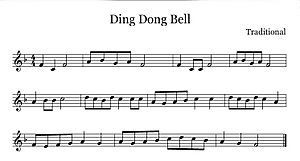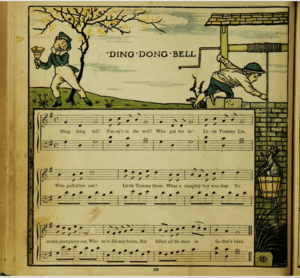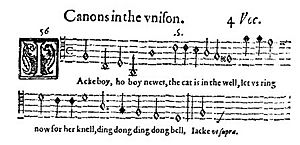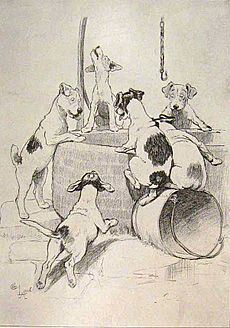Ding Dong Bell facts for kids
Quick facts for kids "Ding Dong Bell" |
|
|---|---|

Sheet music
|
|
| Nursery rhyme | |
| Published | 1580 |
| Songwriter(s) | Unknown |
"Ding Dong Bell" or "Ding Dong Dell" is a very old and well-known English language nursery rhyme. It's a short poem or song that children often learn. This rhyme tells a story about a cat and some children.
What Are the Lyrics?
The most common version of the rhyme you hear today goes like this:
Ding, dong, bell,
Pussy’s in the well.
Who put her in?
Little Johnny Flynn.
Who pulled her out?
Little Tommy Stout.
What a naughty boy was that,
To try to drown poor pussy cat,
Who never did him any harm,
But ate all of the mice in the farmer's barn.
Where Did This Rhyme Come From?
The first time we know about this rhyme being written down was in 1580. A person named John Lant, who was an organist at Winchester Cathedral, wrote down a similar rhyme. It said:
Jacke boy, ho boy newes,
The cat is in the well,
Let us ring now for her Knell,
Ding dong ding dong Bell.
Later, in 1609, the rhyme was printed in a music book called Pammelia, Musicks Miscellanie by Thomas Ravenscroft. In this book, it was written as a song for four voices to sing together.
The famous writer William Shakespeare also used the phrase 'Ding, dong, bell' in some of his plays. For example, in his play The Tempest, a character says:
Sea nymphs hourly ring his knell:
Hark! Now I hear them - Ding, dong, bell.
He also used it in The Merchant of Venice:
Let us all ring fancy's knell;
I'll begin it - Ding, dong, bell.
The version of the rhyme that sounds most like the one we know today first appeared in a book called Mother Goose's Melody. This book was published in London around 1765. In some older versions, the cat was saved by "Dog with long snout." Over time, the names of the boys in the rhyme changed too. "Johnny Flynn" was sometimes called "Tommy O' Linne" or "Tommy Quin."
Changing the Rhyme
The modern version of "Ding Dong Bell" is already a bit softer than the very first ones. This is because people wanted the rhyme to have a happier ending for children.
In 1949, a writer named Geoffrey Hall created a different version in his book New Nursery Rhymes for Old. His version changed the story so the cat was helped, not harmed:
Ding dong bell
Pussy's at the well
Who took her there?
Little Johnny Hare.
Who'll bring her in?
Little Tommy Thin.
What a jolly boy was that
To get some milk for pussy cat
Who ne'er did any harm
But played with the mice in
His father's barn.
Sometimes, you might also hear a modern version that uses the word "kitty" instead of "pussy." This is another way to make the rhyme more friendly and gentle.




